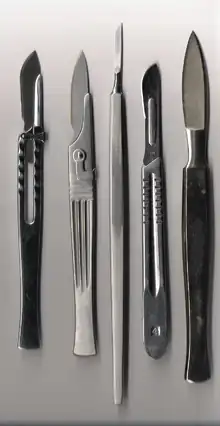Surgical instrument

A surgical instrument is a specialized tool or device, typically made of surgical steel, used during surgery to clamp, cut, dissect, retract, or otherwise manipulate and/or modify biological tissue.
There are many different kinds of surgical instruments. Some surgical instruments are designed for use across all types of surgeries, while others are for specific surgeries. The nomenclature of a given surgical instrument can follow one of several broad naming patterns - describing the action it performs (e.g., hemostat), bearing the namesake of its inventor (e.g., Debakey forceps), or a compound name relating to the surgery itself (e.g. a dermatome).
Surgical instruments must be decontaminated and sterilized between uses to minimize both the risks of infection and the introduction of foreign material during surgery. Within hospitals, this is typically performed by a dedicated sterile services department, utilizing steam autoclaves among other sterilization methods.
The expression surgical instrumentation is somewhat interchangeably used with surgical instruments[1] - however, this term more specifically means the process of providing assistance to a surgeon with the proper handling of surgical instruments during an operation. Within the United States, this is typically performed by a specialized professional called a surgical technologist, but nurses or radiographers with specific training may also do so depending on the state and facility policy. Sometimes surgical instrumentation is referred to as "passing instruments."
Classification
There are many classes of surgical instruments, with a general naming scheme relating to the broad function of a given instrument:
- Grasping instruments, such as forceps, used to hold and manipulate tissue
- Clamping instruments, such as hemostats for blood vessels, and bowel clamps for bowel
- Surgical scissors, such as facelift scissors, tenotomy scissors, or suture scissors, used to cut and dissect tissue
- Saws, which can be powered or unpowered, used for cutting bone or performing amputations
- Powered drills, used to put holes in bones for screw implantation
- Bone cutters, a plethora of plier-like devices for modifying bone, such as rongeurs
- Needle drivers, also known as needle holders, used to hold suture needle while passing it through tissue, as well as to grasp suture while instrument knot tying
- Retractors, used to pull on tissue for better access into a wound or surgical incision
- Distractors, used to spread tissue or bone for access via opposing hooks or blades
- Stereotactic devices
- Cutting instruments - scalpels (often referred to as knives) for cutting and dissecting tissue, trocars for gaining laparoscopic or thoracoscopic access
- Dilators, for dilating narrow passages or sphincters, such as the cervix, the urethra, or the anal sphincter
- Speculums, for gaining access to and through narrow passages, such as the ear canal, the nasopharyngeal passage, and the vagina
- Suction tips, such as Frazier, Andrew, or Poole suction tips, for removal of bodily fluids
- Sealing devices, such as surgical staplers
- Irrigation and injection needles, tips and tubes, for introducing fluid into or onto bodily tissue
- Miscellaneous powered devices, such as cranial drills for gaining access to the brain through the skull, orthopedic drills used to put holes in bones for screw implantation, and dermatomes for skin graft acquisition
- Scopes and probes, including fiber optic endoscopes and tactile probes
- Carriers and appliers for optical, electronic, and mechanical devices
- Ultrasound tissue disruptors, cryotomes and cutting laser guides
- Measurement devices, such as rulers and calipers
An important relative distinction regarding surgical instruments is the amount of bodily disruption or tissue trauma that their use might cause the patient. In essence, there are two types of surgical instruments - 'traumatic,' causing guaranteed tissue damage, and 'atraumatic,' causing minimal to no tissue damage. Atraumatic instruments are sometimes also referred to as minimally invasive.
See also
| Wikimedia Commons has media related to Surgical instruments. |
Gallery
References
- ↑ Renee Nimitz, Surgical Instrumentation: an Interactive Approach (Saunders, 2010) 1416037020, pxiii
External links
- Edgar R. McGuire Historical Medical Instrument Collection from the University at Buffalo Libraries
Bibliography
- Wells, MP, Bradley, M: Surgical Instruments A Pocket Guide. W.B. Saunders, 1998.





